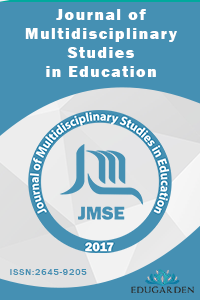Concept Term in Architectural Education and Profession
Concept Term in Architectural Education and Profession
Notions that people acquire from nature and the interpretations they make from these notions within a certain framework constitute the beginning of all actions under the name of creativity. The subject of this study, which is oriented to the process that goes through the mind of the architectural designer in the process of starting his designs, is to examine the concept creation process in the environment of architectural design education and architectural profession. In this study, the place of the "concept" subject in architectural design, the level of the "concept" in the universities in our country and the view of the architects to the "concept" are investigated. The general definitions of the concept, the differences between "concept" and "notion", which are frequently encountered in design action but are used interchangeably from time to time due to the fact that they come to our language later, are examined. In this context, compulsory and elective courses on the concept and/or content of undergraduate programs of universities providing architectural education in Turkey were investigated. The presence status in the content of compulsory or elective courses is shown with the help of charts. A questionnaire was prepared and the results were evaluated with graphic expressions in order to get an idea about the view of the architects and students on the concept subject and the position of the concept in the architectural profession and architectural education.
Keywords:
Architecture, Concept, Architectural Education Architectural Profession, Notion,
___
- Altunışık, R., Çoşkun, R., Bayraktaroğlu, S., Yıldırım E. . (2012). Sosyal Bilimlerde Araştırma Yöntemleri.
- Anderson, J. (2011). Mimari Tasarım (Mimarlık Temelleri). Literatür Yayınları (Architectural Design/Ava Publishing).
- Atakan, G. (2014). Yaratıcı Tasarım Sürecinde Bilişsel Yaklaşım ve Üstbilişsel Farkındalık [Yayınlanmamış Yüksek Lisans Tezi, Hacettepe Üniversitesi Güzel Sanatlar Enstitüsü].
- Atkin, A. (2010). Peirce’s Theory of Signs. Mind, 119(475), 852-855. https://doi.org/https://doi.org/10.1093/mind/fzq066
- Aydınlı, S. (1993). Mimarlıkta estetik değerler. İTÜ Mimarlık Fakültesi Baskı Atölyesi.
- Bayazıt, N. (1994) Endüstri Ürünlerinde ve Mimarlıkta Tasarlama Metodlarına Giriş, Literatür Yayıncılık, İstanbul, Türkiye.
- Bilir, S. (2013). Mekan Tasarımında Kavram Geliştirme Sürecine Analitik Bir Yaklaşım. [Yayınlanmamış Yüksek Lisans Tezi, Hacettepe Üniversitesi Güzel Sanatlar Enstitüsü İç Mimarlık ve Çevre Tasarımı Ana Sanat Dalı İç Mimarlık Sanat Dalı].
- Çelik, M., & Turgay, O. (2001). Tasarım Eğitiminde Kavram Oluşturma ve Kavrama Ulaşma. Mimari Tasarım Eğitimi: Bütünleşme 2, Ulusal Sempozyum, İstanbul.
- Dorsey, J., Xu, S., Smedresman, G., Rushmeier, H., & McMillan, L. (2007). The Mental Canvas: A Tool for Conceptual Architectural Design and Analysis, 15th Pacific Conference on Computer Graphics and Applications (PG'07). USA.
- Eissa, D. (2019). Concept generation in the architectural design process: A suggested hybrid model of vertical and lateral thinking approaches. Thinking Skills and Creativity, 33. https://doi.org/100589
- Erman, O., & Yılmaz, N. (2017). Mimari Tasarımda Konsept ve Bağlam İlişkisi Üzerine. Uluslararası Hakemli Tasarım ve Mimarlık Dergisi, 10, 96-115.
- Farooq, M. S., Nadir, R. M., Rustam, F., Hur, S., Park, Y., & Ashraf, I. (2022). Nested Bee Hive: A Conceptual Multilayer Architecture for 6G in Futuristic Sustainable Smart Cities. Sensors, 22. https://doi.org/s22165950
- Gündüzlü, E. B., & Sönmez, B. E. (2021). İç Mekân Tasarımında Özgünlük ve Konsept: Özgün ve Özgün Olmayan Mekânların Karşılaştırılması. STD, 243-267.
- Hançerlioğlu, O. (1980). Felsefe Ansiklopedisi. Remzi Kitabevi.
- Hasipi, E. (2021). Üsküp'ün Yeni Yüzü: 'Üsküp 2014' Projesinin Konsept Tasarımı Açısından İncelenmesi. [Yayınlanmamış Yüksek Lisans Tezi, Trakya Üniversitesi]. Edirne.
- Kürüm, H. (2021). Mimari Tasarım Eğitiminde Konseptin Mimarlık Mesleğinde Yerinin Sorgulanması [Yayınlanmamış Yüksek Lisans Tezi, Trakya Üniversitesi]. Edirne.
- MİAK. (2023). Mimarlık Eğitimi Akreditasyon Derneği. http://www.miak.org/?p=sayfalar&sayfa_id=84
- Onbay, E. (2020). 21. Yüzyıl Dünya Fuarlarında (Expo) Türkiye'nin Mimari Temsili Aurum 4(1), 135-152.
- Önal, G. K. (2011). Yaratıcılık ve kültürel bağlamda mimari tasarım süreci. Uludağ Üniversitesi Mühendislik Fakültesi Dergisi, 16(1).
- Özdağ, E. S. (2018). Mekan Tasarımında Kavramsal Tema (Konsept) Kavramı. [Yayınlanmamış Yüksek Lisans Tezi, Kocaeli Üniversitesi]. Kocaeli.
- P. Michalik, J. Š. a. I. Z. (2014). Concept definition for Big Data architecture in the education system IEEE 12th International Symposium on Applied Machine Intelligence and Informatics (SAMI), Slovakia,.
- Pena, M. L. C., Carballal, A., Rodríguez-Fernandez, N., Santos, I., & Romero, J. (2021). Artificial intelligence applied to conceptual design. A review of its use in architecture Automation in Construction, 124, 1-30. https://doi.org/103550
- T.Ü. (2020). Mimarlık Fakültesi Öğrenci İşleri Birimi.
- TMMOB. (2021). Mimarlar Odası Mevzuatı. http://www.mimarlarodasi.org.tr/?sayfa=belge&sub=list&bid=220&mid=220
- Uyar, A. (2021). Mimari Tasarımda Konseptin Çağdaş Sanat Müzeleri Üzerinden Değerlendirilmesi [ Yayınlanmamış Yüksek Lisans Tezi, Necmettin Erbakan Üniversitesi ]. Konya.
- Wynn, D., & Clarkson, J. (2005). Models of Designing. In Design process improvement: a review of current practice (pp. 34-59). Springer.
- Yıldırım, İ. I. (2016). Marka Kimliği ve Mimari Tasarım İlişkisi. Yapı, 410, 132-137.
- YÖKATLAS. (2021). Mimarlık Programı Bulunan Tüm Üniversiteler. https://yokatlas.yok.gov.tr/lisans-bolum.php?b=10155
- ISSN: 2645-9205
- Yayın Aralığı: Yılda 4 Sayı
- Başlangıç: 2017
- Yayıncı: Edugarden Org. Kongre Ve Yay. San. Ve Tic. Ltd. Şti.
